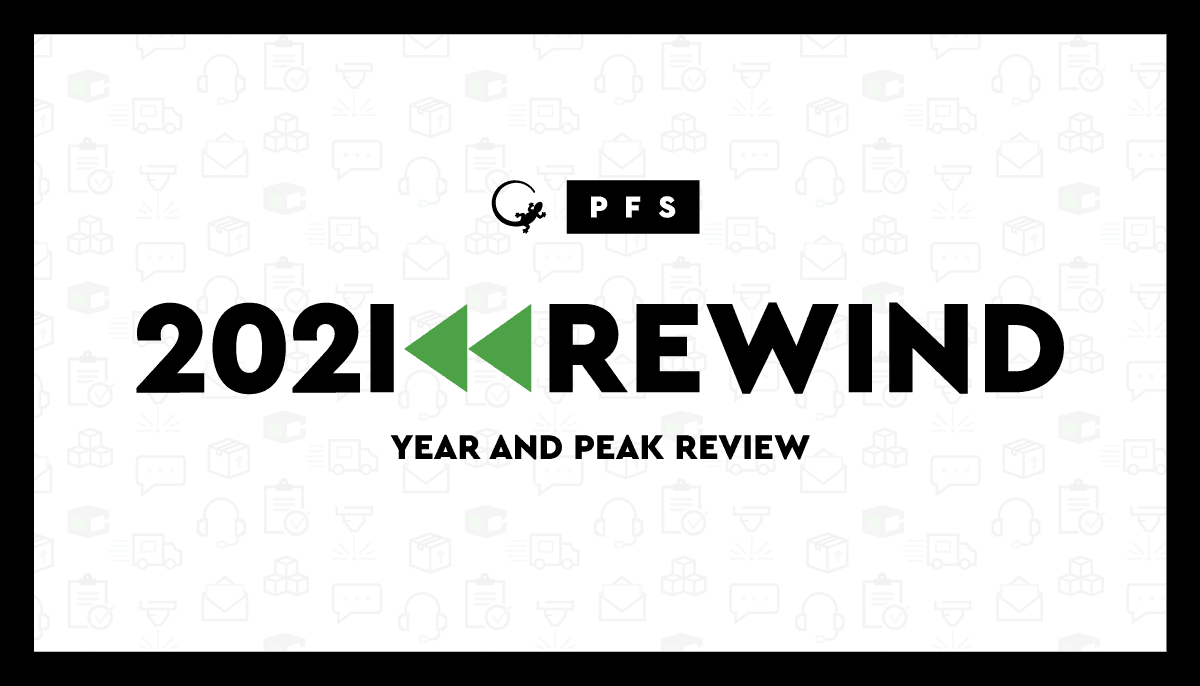
Preparing for Last-Minute Shoppers During a Pandemic
As carriers warn about capacity concerns and supply chain disruption continues, PFS looks at how brands and retailers can prepare for last-minute shoppers in 2020.
The unusual 2020 holiday season is already in full force having kicked-off in mid-October. This change elongated the holiday shopping window to around eight weeks from the typical three to four-week Thanksgiving to Christmas rush.
The goal for retailers this year is to bring eCommerce volume earlier into the quarter, to avoid supply chain constraints later into the peak season. In 2020, a large delay in consumer purchasing could yield more significant impacts than ever before. Many retailers are already three to four times over forecast from an eCommerce perspective, so any late holiday buying surges could further the ongoing supply chain bottleneck.
Combined with the impacts of operating in a pandemic including strained fulfillment networks, tighter warehouse safety protocols and predicted carrier delays, it is the perfect storm for retailers to struggle with last-minute holiday shopping.
Retailers push for an earlier peak
With all of the ongoing variables this holiday season, the best way to consumers can ensure they will get their gifts delivered on-time is to order early. Retailers have made it a priority to pull as much eCommerce volume forward as possible to flatten the demand curve. Salesforce predicts that $6 billion of US retail spending will still take place during Cyber Week in November, with $26 billion being pulled into October this year (1).
Stronger customer communications have been a primary way brands have tried to enforce this shift. You likely have seen an uptick in promotions earlier in the holiday cycle than before; this is not by accident. Converting more early shoppers helps retailers ensure revenue and a better holiday experience for consumers. According to NRF, 52% of brands started holiday promotions in October, while just 2% will in December (2).
Some brands have increased direct messaging on early promotions stating that the best prices are available now and will actually increase the closer we get to peak. Others have shared messaging stating that supplies are running low and consumers must act now before products are gone. While some brands are even offering gift cards for consumers who participate in early shopping. Incentivizing shoppers and creating a sense of urgency is vital to drive behavioral change, something we have already seen with early holiday co-promotion around Amazon Prime Day and Singles Day.
Is there hope for last-minute shoppers?
In short, yes! Everyone knows that not every shopper will heed these messages, other solutions must be on the table. Despite efforts to retrain consumer behavior and buying patterns, old habits die hard and it is inevitable we will see some shoppers procrastinate this holiday season. So, how can brands and retailers prepare for these unavoidable last-minute shoppers?
Offset carrier dependence with alternative fulfillment
Alternative fulfillment methods can help lessen last-mile complications. By leveraging non-traditional fulfillment methods like micro or pop-up fulfillment as well as ramping up Buy-Online, Pick-Up In-Store (BOPIS) or curbside offerings, brands can look to offset some of the drawbacks to delayed or late ordering. Case in point, holiday growth for BOPIS or click and collect orders is expected to top 40% YoY in 2020 (3).
These alternative fulfillment solutions can help to shorten the supply chain by getting inventory closer to consumers, lessening strain on central distribution centers by dispersing products in various regional hubs.
Alternate fulfillment also helps bypass the carrier conundrum facing brands this holiday season. Even if your supply chain is optimized, many national carriers have already said to expect significant delays and surcharges the closer we get to peak. Salesforce predicts that over 700 million packages are at risk of not arriving before Christmas, with retailers facing $40 billion in delivery surcharges (1).
With alternative fulfillment, consumers have the option to pick-up items from local stores and pop-up fulfillment centers. Or, brands can localize the last-mile by looking to ride-sharing platforms or other local courier networks to deliver products. We expect to see more of this option in the future; it is very cost-efficient and offers significant agility.
Create more seamless omnichannel experiences
A unified front across all aspects of retail this holiday season will be necessary for brands to achieve success. Marketing, customer service and fulfillment operations must be on the same page and working in sync to ensure seamless customer experiences.
Align your marketing messaging with supply chain activity to make sure promotions are feasible from a fulfillment perspective and you are proactively communicating with customers. For example, some of our clients are utilizing pre-set thresholds that will launch automated messaging and customer communications when certain inventory limits are triggered.
Further, we will see more widespread adoption of inventory transparency for omnichannel brands. Low-stock indications on eCommerce sites will help create a sense of urgency, while a robust technology stack can open up alternative options for customers, pointing shoppers to locations closest to them to pick-up items as opposed to waiting for delivery.
These shifts must be coordinated across all company business units to ensure customer communication is consistent across channels including direct marketing, website banner promotions, social media and customer service.
Looking Forward
Earlier promotional schedules allow for guaranteed revenues and are easier for brands to forecast and support. Simultaneously, a shift away from the traditional Black Friday rush could give way to more sustainable and healthy consumer behaviors around the holidays. The pieces are in place for brands to drive significant change this holiday season, despite the limitations of COVID-19. Brands who can adapt their strategies in this pivotal year are sure to be rewarded as we enter a new normal in 2021.


